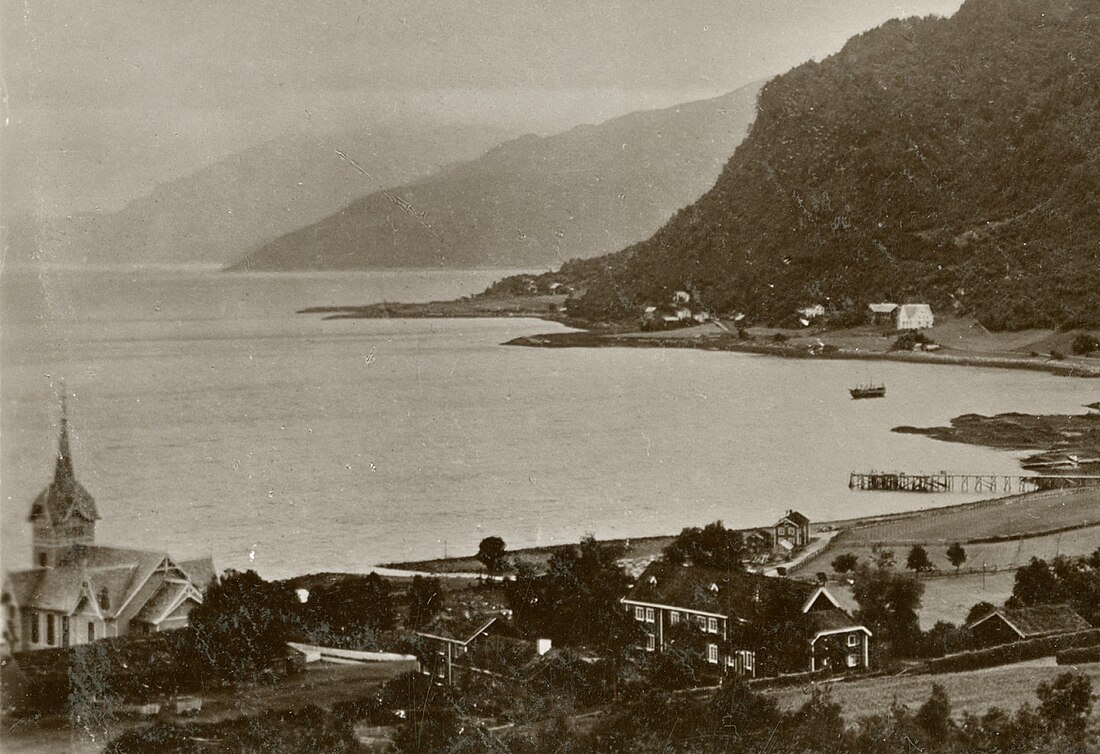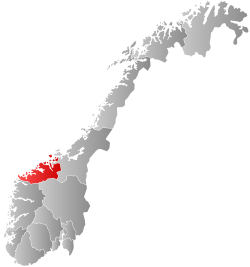Top Qs
Timeline
Chat
Perspective
Stangvik Municipality
Former municipality in Møre og Romsdal, Norway From Wikipedia, the free encyclopedia
Remove ads
Stangvik is a former municipality in Møre og Romsdal county, Norway. The 511-square-kilometre (197 sq mi) municipality existed from 1838 until its dissolution in 1965. The municipality of Stangvik (historically spelled Stangvig) encompassed much of the area surrounding the Trongfjorden and the smaller fjords that branch off of it such as the Ålvundfjorden, Stangvikfjorden, and Todalsfjorden. The municipality was mostly located in what is now Surnadal Municipality and also small portions of what is now Sunndal Municipality and Tingvoll Municipality. The administrative centre of the municipality was the village of Stangvik where Stangvik Church is located.[6]
Prior to its dissolution in 1965, the 511-square-kilometre (197 sq mi) municipality was the 203rd largest by area out of the 525 municipalities in Norway. Stangvik Municipality was the 400th most populous municipality in Norway with a population of about 1,947. The municipality's population density was 3.8 inhabitants per square kilometre (9.8/sq mi) and its population had decreased by 16.1% over the previous 10-year period.[7][8]
Remove ads
General information
Summarize
Perspective


The municipality of Stangvig was established on 1 January 1838 (see formannskapsdistrikt law). According to the 1865 census, the municipality had a population of 2,619.[9] On 1 January 1874, a part of Stangvik Municipality (population: 61) was moved to neighboring Tingvoll Municipality. Then on 1 January 1877, another part of Stangvik Municipality (population: 50) was moved to Surnadal Municipality.[10]
In 1879, parts of Surnadal Municipality (population: 83) and Halsa Municipality (population: 279) were moved to Stangvik Municipality. On 1 January 1886, the Møklegjerdet farm (population: 29), just west of Glærem, was transferred from Stangvik Municipality to Surnadal Municipality. On 1 January 1897, the Sjøflot farm (population: 27), also just west of Glærem, was transferred from Stangvik Municipality to Surnadal Municipality. On 1 May 1895, the area around the Åsskardfjorden and the Hamnesfjorden in the northern part of the municipality was split off to create the new Aasgaard Municipality, leaving Stangvik Municipality with 2,354 inhabitants.[10]
During the 1960s, there were many municipal mergers across Norway due to the work of the Schei Committee. On 1 January 1965, Stangvik Municipality ceased to exist. The district around the village of Ålvund and the Ålvundfjorden (population: 508) was moved to the neighboring Sunndal Municipality, the district around the villages of Åsprong and Sandnes (population: 26) was moved to the neighboring Tingvoll Municipality, and the rest of Stangvik Municipality (population: 1,386), along with all of Åsskard Municipality, was merged into Surnadal Municipality.[10]
Name
The municipality (originally the parish) is named after the old Stangvik farm (Old Norse: Stangarvík) since the first Stangvik Church was built there. The first element is derived from the genitive case of the word stǫng which means "staff" or "pole". This is likely referring to the very straight shape of the shoreline in this area (rather unusual for the very craggy shoreline in western Norway). The last element is vík which means "bay" or "cove".[11]
Churches
The Church of Norway had two parishes (sokn) within Stangvik Municipality. At the time of the municipal dissolution, it was part of the Stangvik prestegjeld and the Indre Nordmøre prosti (deanery) in the Diocese of Nidaros.[8]
Remove ads
Geography
The municipality encompassed much of the area surrounding the Trongfjorden and the smaller fjords that branch off of it such as the Ålvundfjorden, Stangvikfjorden, and Todalsfjorden. The highest point in the municipality was the 1,622-metre (5,322 ft) tall mountain Neådalssnota, on the border with Surnadal Municipality.[1] Åsskard Municipality was to the north, Surnadal Municipality was to the east, Oppdal Municipality (in Sør-Trøndelag county) to the southeast, Ålvundeid Municipality was to the southwest, and Tingvoll Municipality was to the west.
Remove ads
Government
Summarize
Perspective
While it existed, Stangvik Municipality was responsible for primary education (through 10th grade), outpatient health services, senior citizen services, welfare and other social services, zoning, economic development, and municipal roads and utilities. The municipality was governed by a municipal council of directly elected representatives. The mayor was indirectly elected by a vote of the municipal council.[12] The municipality was under the jurisdiction of the Frostating Court of Appeal.
Municipal council
The municipal council (Herredsstyre) of Stangvik was made up of 21 representatives that were elected to four year terms. The tables below show the historical composition of the council by political party.
Mayors
The mayor (Nynorsk: ordførar) of Stangvik was the political leader of the municipality and the chairperson of the municipal council. The following people have held this position (incomplete list):
- 1846–1847: Erik Kaarvatn[20]
- 1848–1849: Lars L. Mo[21]
- 1850–1851: Bersvein Røkkum[22]
- 1852–1853: Bersvein Brøske[23]
- 1858–1877: Christian Bruseth[24]
- 1878–1883: Bersvein Brøske[23]
- 1884–1885: Lars J. Bæverfjord[25]
- 1886–1889: Bersvein Brøske[23]
- 1890–1894: Lars L. Mo[26]
- 1894–1907: Lars Røkkum[27][28]
- 1907–1916: Peder J. Kvande[29][30]
- 1919–1922: Kristian Bruseth[31]
- 1922–1937: Josva Halle[32][33]
- 1937–1941: Erling Torhus (Ap)[34]
- 1945–1945: Josva Halle[35]
- 1945–1947: Albert Halseth[36]
- 1947–1955: Anders J. Halset[37]
- 1955–1963: Olav T. Halle (Bp)[38][39]
- 1963–1964: Ola Torhus (Ap)[38]
Remove ads
See also
References
Wikiwand - on
Seamless Wikipedia browsing. On steroids.
Remove ads



